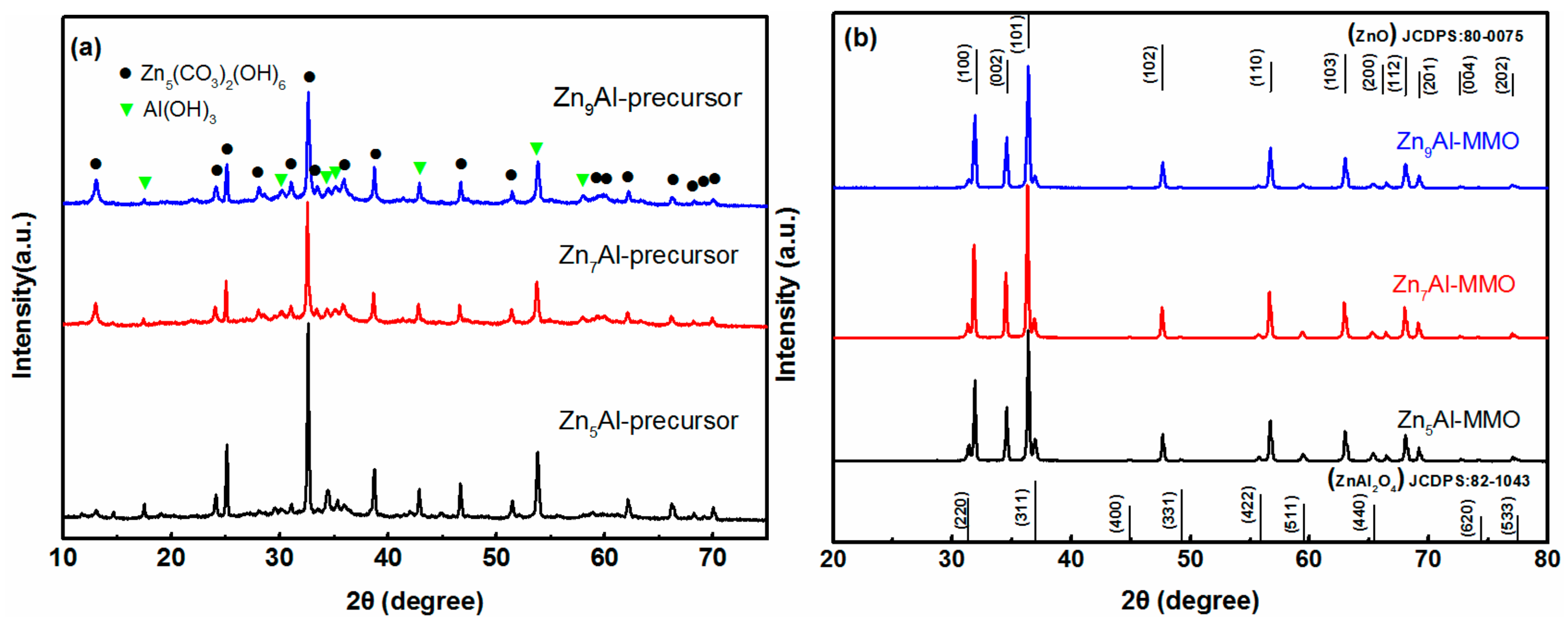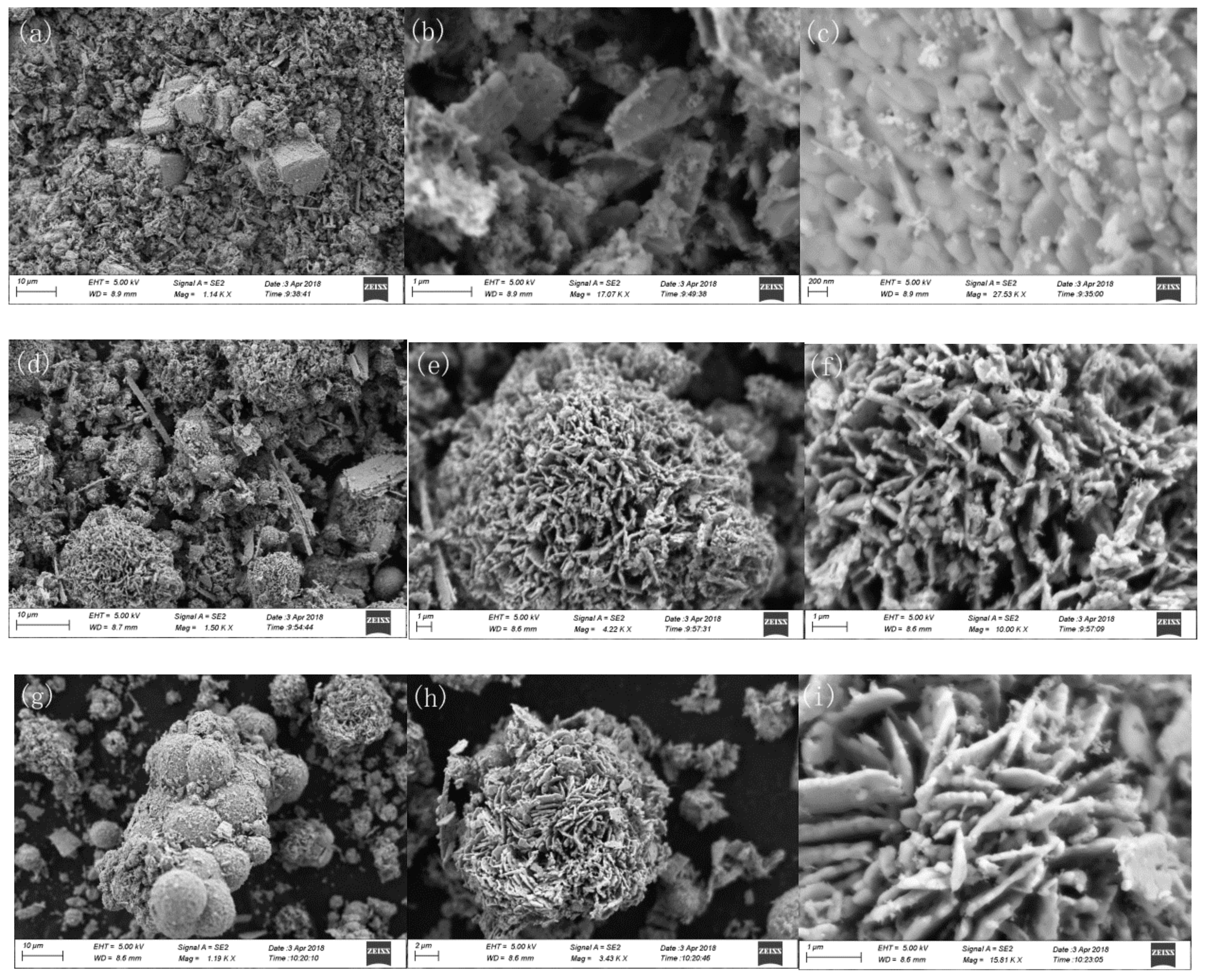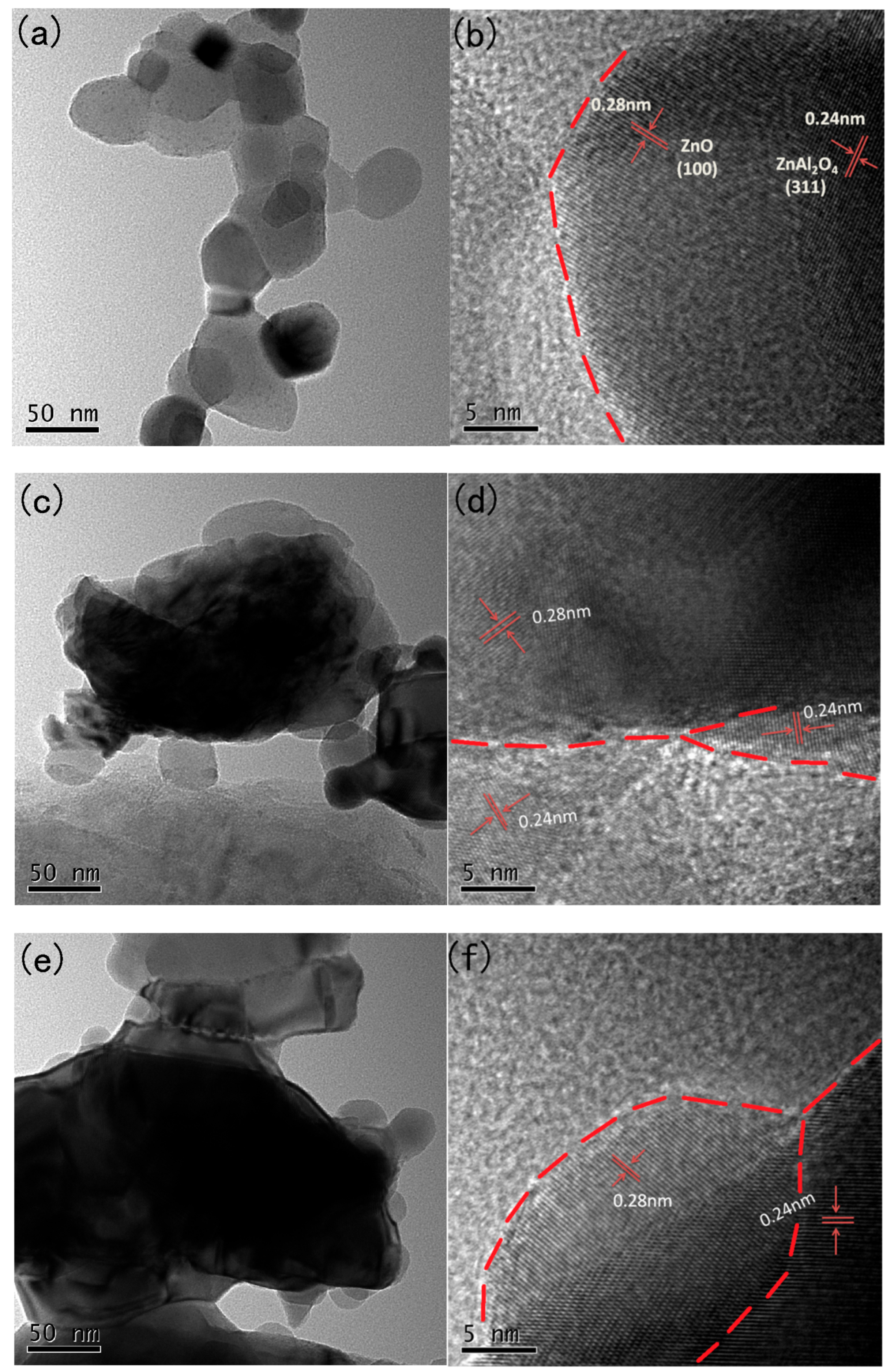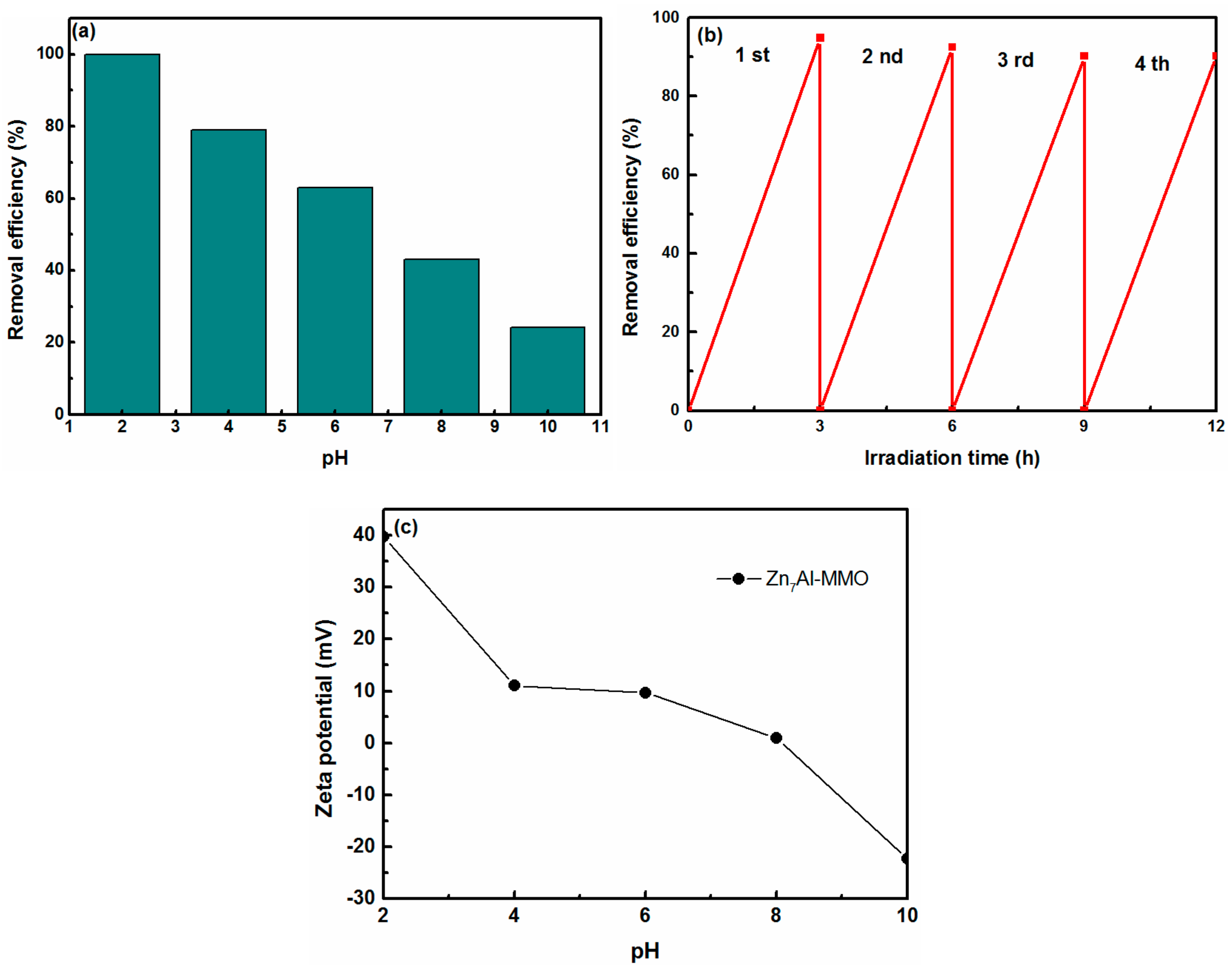ZnO/ZnAl2O4 Nanocomposite with 3D Sphere-Like Hierarchical Structure for Photocatalytic Reduction of Aqueous Cr(VI)
Abstract
:1. Introduction
2. Experimental Section
2.1. Synthesis of ZnO/ZnAl2O4 Nanocomposite
2.2. Characterization
2.3. Photocatalytic Performance Tests
3. Results and Discussion
3.1. Characterization of ZnnAl Precursors and ZnnAl-MMO Nanocomposites
3.2. Photoreduction of Aqueous Cr(VI) under UV Light
4. Conclusions
Author Contributions
Funding
Conflicts of Interest
References
- Andreozzi, R.; Somma, I.D.; Marotta, R.; Pinto, G.; Pollio, A.; Spasiano, D. Oxidation of 2,4-dichlorophenol and 3,4-dichlorophenol by means of Fe(III)-homogeneous photocatalysis and algal toxicity assessment of the treated solutions. Water Res. 2011, 45, 2038–2048. [Google Scholar] [CrossRef] [PubMed]
- Gupta, V.K.; Agarwal, S.; Saleh, T.A. Chromium removal by combining the magnetic properties of iron oxide with adsorption properties of carbon nanotubes. Water Res. 2011, 45, 2207–2212. [Google Scholar] [CrossRef] [PubMed]
- Benoit, D.A. Toxic effects of hexavalent chromium on brook trout (salvelinus fontinalis) and rainbow trout (salmo gairdneri). Water Res. 1976, 10, 497–500. [Google Scholar] [CrossRef]
- Rengaraj, S.; Yeon, K.H.; Moon, S.H. Removal of chromium from water and wastewater by ion exchange resins. J. Hazard. Mater. 2001, 87, 273–287. [Google Scholar] [CrossRef]
- Danis, U. Chromate removal from water using red mud and crossflow microfiltration. Desalination 2005, 181, 135–143. [Google Scholar] [CrossRef]
- Chang, L.Y. Alternative chromium reduction and heavy metal precipitation methods for industrial wastewater. Environ. Prog. 2004, 22, 174–182. [Google Scholar] [CrossRef]
- Nakajima, A.; Baba, Y. Mechanism of hexavalent chromium adsorption by persimmon tannin gel. Water Res. 2004, 38, 2859–2864. [Google Scholar] [CrossRef] [PubMed]
- Dabrowski, A.; Hubicki, Z.; Podkościelnya, P.; Robens, E. Selective removal of the heavy metal ions from waters and industrial wastewaters by ion-exchange method. Chemosphere 2004, 56, 91–106. [Google Scholar] [CrossRef] [PubMed]
- Rana, P.; Mohan, N.; Rajagopal, C. Electrochemical removal of chromium from wastewater by using carbon aerogel electrodes. Water Res. 2004, 38, 2811–2820. [Google Scholar] [CrossRef] [PubMed]
- Das, C.; Patel, P.; De, S.; DasGupta, S. Treatment of tanning effluent using nanofiltration followed by reverse osmosis. Sep. Purif. Technol. 2006, 50, 291–299. [Google Scholar] [CrossRef]
- Chenthamarakshan, C.R.; Rajeshwar, K.; Wolfrum, E.J. Heterogeneous photocatalytic reduction of Cr(VI) in UV-irradiated titania suspensions: Effect of protons, ammonium ions, and other interfacial aspects. Langmuir 2000, 16, 2715–2721. [Google Scholar] [CrossRef]
- Kumar, S.; Baruah, A.; Tonda, S.; Kumar, B.; Shanker, V.; Sreedhar, B. Cost-effective and eco-friendly synthesis of novel and stable N-doped ZnO/g-C3N4 core-shell nanoplates with excellent visible-light responsive photocatalysis. Nanoscale 2014, 6, 4830–4842. [Google Scholar] [CrossRef] [PubMed]
- Arin, J.; Thongtem, S.; Thongtem, T. Single-step synthesis of ZnO/TiO2 nanocomposites by microwave radiation and their photocatalytic activities. Mater. Lett. 2013, 96, 78–81. [Google Scholar] [CrossRef]
- Das, S.N.; Choi, J.H.; Kar, J.P.; Myoung, J.M. Tunable and reversible surface wettability transition of vertically aligned ZnO nanorod arrays. Appl. Surf. Sci. 2009, 255, 7319–7322. [Google Scholar] [CrossRef]
- Shaik, U.P.; Kshirsagar, S.; Krishna, M.G.; Tewari, S.P.; Dhar Purkayastha, D.; Madhurima, V. Growth of superhydrophobic zinc oxide nanowire thin films. Mater. Lett. 2012, 75, 51–53. [Google Scholar] [CrossRef]
- Kwak, G.; Seol, M.; Tak, Y.; Yong, K. Superhydrophobic ZnO nanowire surface: Chemical modification and effects of UV irradiation. J. Phys. Chem. C 2009, 113, 12085–12089. [Google Scholar] [CrossRef]
- Karuppiah, C.; Palanisamy, S.; Chen, S.M.; Veeramani, V.; Periakaruppan, P. Direct electrochemistry of glucose oxidase and sensing glucose using a screen-printed carbon electrode modified with graphite nanosheets and zinc oxide nanoparticles. Microchim. Acta 2014, 181, 1843–1850. [Google Scholar] [CrossRef]
- Li, Y.; Sasaki, T.; Shimizu, Y.; Koshizaki, N. A hierarchically ordered TiO2 hemispherical particle array with hexagonal-non-close-packed tops: Synthesis and stable superhydrophilicity without UV irradiation. Small 2008, 4, 2286–2291. [Google Scholar] [CrossRef] [PubMed]
- Li, Y.; Li, C.; Cho, S.O.; Duan, G.; Cai, W. Silver hierarchical bowl-like array: Synthesis, superhydrophobicity, and optical properties. Langmuir 2007, 23, 9802–9807. [Google Scholar] [CrossRef] [PubMed]
- Palanisamy, S.; Chen, S.M.; Sarawathi, R. A novel nonenzymatic hydrogen peroxide sensor based on reduced graphene oxide/ZnO composite modified electrode. Sens. Actuators B Chem. 2012, 166–167, 372–377. [Google Scholar] [CrossRef]
- Palanisamy, S.; Vilian, A.T.E.; Chen, S.M. Direct electrochemistry of glucose oxidase at reduced graphene oxide/zinc oxide composite modified electrode for glucose sensor. Int. J. Electrochem. Sci. 2012, 7, 2153–2163. [Google Scholar]
- Li, J.; Fan, H.; Jia, X. Multilayered ZnO nanosheets with 3D porous architectures: Synthesis and gas sensing application. J. Phys. Chem. C 2010, 114, 14684–14691. [Google Scholar] [CrossRef]
- Wang, W.W.; Zhu, Y.J.; Yang, L.X. ZnO-SnO2 hollow spheres and hierarchical nanosheets: Hydrothermal preparation, formation mechanism, and photocatalytic properties. Adv. Funct. Mater. 2006, 17, 59–64. [Google Scholar] [CrossRef]
- Liu, B.; Zeng, H.C. Fabrication of ZnO “dandelions” via a modified kirkendall process. J. Am. Chem. Soc. 2004, 126, 16744–16746. [Google Scholar] [CrossRef] [PubMed]
- Xu, L.; Li, Z.; Cai, Q.; Wang, H.; Gao, H.; Lv, W.; Liu, J. Precursor template synthesis of three-dimensional mesoporous ZnO hierarchical structures and their photocatalytic properties. CrystEngComm 2010, 12, 2166–2172. [Google Scholar] [CrossRef]
- Lu, H.; Wang, S.; Zhao, L.; Li, J.; Dong, B.; Xu, Z. Hierarchical ZnO microarchitectures assembled by ultrathin nanosheets: Hydrothermal synthesis and enhanced photocatalytic activity. J. Mater. Chem. 2011, 21, 4228–4234. [Google Scholar] [CrossRef]
- Li, Y.; Sasaki, T.; Shimizu, Y.; Koshizaki, N. Hexagonal-close-packed, hierarchical amorphous TiO2 nanocolumn arrays: Transferability, enhanced photocatalytic activity, and superamphiphilicity without uv irradiation. J. Am. Chem. Soc. 2008, 130, 14755–14762. [Google Scholar] [CrossRef] [PubMed]
- Lu, W.; Gao, S.; Wang, J. One-pot synthesis of Ag/ZnO self-assembled 3D hollow microspheres with enhanced photocatalytic performance. J. Phys. Chem. C 2008, 112, 16792–16800. [Google Scholar] [CrossRef]
- Dixit, H.; Tandon, N.; Cottenier, S.; Saniz, R.; Lamoen, D.; Partoens, B.; Speybroeck, V.V.; Waroquier, M. Electronic structure and band gap of zinc spinel oxides beyond LDA: ZnAl2O4, ZnGa2O4 and ZnIn2O4. New J. Phys. 2011, 13, 063002. [Google Scholar] [CrossRef]
- Yan, J.H.; Chen, H.; Zhang, L.; Jiang, J.Z. Inactivation of Escherichia coil on immobilized CuO/CoFe2O4-TiO2 thin-film under simulated sunlight irradiation. Chin. J. Chem. 2011, 29, 1133–1138. [Google Scholar] [CrossRef]
- Zhang, L.; Yan, J.; Zhou, M.; Yang, Y.; Liu, Y.N. Fabrication and photocatalytic properties of spheres-in-spheres ZnO/ZnAl2O4 composite hollow microspheres. Appl. Surf. Sci. 2013, 268, 237–245. [Google Scholar] [CrossRef]
- Zhao, X.; Wang, L.; Xu, X.; Lei, X.; Xu, S.; Zhang, F. Fabrication and photocatalytic properties of novel ZnO/ZnAl2O4 nanocomposite with ZnAl2O4 dispersed inside zno network. AIChE J. 2011, 58, 573–582. [Google Scholar] [CrossRef]
- Carriazo, D.; Arco, M.D.; García-López, E.; Marcì, G.; Martín, C.; Palmisano, L.; Rives, V. Zn, Al hydrotalcites calcined at different temperatures: Preparation, characterization and photocatalytic activity in gas-solid regime. J. Mol. Catal. A Chem. 2011, 342, 83–90. [Google Scholar] [CrossRef]
- Huo, R.; Kuang, Y.; Zhao, Z.; Zhang, F.; Xu, S. Enhanced photocatalytic performances of hierarchical ZnO/ZnAl2O4 microsphere derived from layered double hydroxide precursor spray-dried microsphere. J. Colloid Interface Sci. 2013, 407, 17–21. [Google Scholar] [CrossRef] [PubMed]
- Aznan, N.A.K.; Johan, M.R. Quantum size effect in ZnO nanoparticles via mechanical milling. J. Nanomater. 2012, 2012, 490–494. [Google Scholar] [CrossRef]
- Cho, S.; Lee, K.H. Formation of zinc aluminum mixed metal oxide nanostructures. J. Alloys Compd. 2011, 509, 8770–8778. [Google Scholar] [CrossRef]
- Rehman, S.; Ullah, R.; Butt, A.M.; Gohar, N.D. Strategies of making TiO2 and ZnO visible light active. J. Hazard. Mater. 2009, 170, 560–569. [Google Scholar] [CrossRef] [PubMed]
- Hao, Y.; Zhang, L.; Zhang, Y.; Zhao, L.; Zhang, B. Synthesis of pearl necklace-like ZnO-ZnWO4 heterojunctions with enhanced photocatalytic degradation of Rhodamine B. RSC Adv. 2017, 7, 26179–26184. [Google Scholar] [CrossRef]
- Niu, M.; Huang, F.; Cui, L.; Huang, P.; Yu, Y.; Wang, Y. Hydrothermal synthesis, structural characteristics, and enhanced photocatalysis of SnO2/a-Fe2O3 semiconductor nanoheterostructures. ACS Nano 2010, 4, 681–688. [Google Scholar] [CrossRef] [PubMed]
- Tak, Y.; Kim, H.; Lee, D.; Yong, K. Type-II CdS nanoparticle-ZnO nanowire heterostructure arrays fabricated by a solution process: Enhanced photocatalytic activity. Chem. Commun. 2008, 4585–4587. [Google Scholar] [CrossRef] [PubMed]
- Yuan, X.; Jing, Q.; Chen, J.; Li, L. Photocatalytic Cr(VI) reduction by mixed metal oxide derived from ZnAl layered double hydroxide. Appl. Clay Sci. 2017, 143, 168–174. [Google Scholar] [CrossRef]
- Yuan, X.; Zhou, C.; Jin, Y.; Jing, Q.; Yang, Y.; Shen, X.; Tang, Q.; Mu, Y.; Du, A.-K. Facile synthesis of 3D porous thermally exfoliated g-C3N4 nanosheet with enhanced photocatalytic degradation of organic dye. J. Colloid Interface Sci. 2016, 468, 211–219. [Google Scholar] [CrossRef] [PubMed]
- Wang, Q.; Shang, J.; Song, H. Factors influencing the photoelectrocatalytic reduction of Cr(VI) over TiO2 nanotube arrays. Chin. J. Catal. 2011, 32, 1525–1530. [Google Scholar] [CrossRef]
- Alanis, C.; Natividad, R.; Barrera-Diaz, C.; Martínez-Miranda, V.N.; Prince, J.; Valente, J.S. Photocatalytically enhanced Cr(VI) removal by mixed oxides derived from MeAl (Me: Mg and/or Zn) layered double hydroxides. Appl. Catal. B Environ. 2013, 140–141, 546–551. [Google Scholar] [CrossRef]
- Jin, Z.; Zhang, Y.X.; Meng, F.L.; Jia, Y.; Luo, T.; Yu, X.Y.; Wang, J.; Liu, J.H.; Huang, X.J. Facile synthesis of porous single crystalline ZnO nanoplates and their application in photocatalytic reduction of Cr(VI) in the presence of phenol. J. Hazard. Mater. 2014, 276, 400–407. [Google Scholar] [CrossRef] [PubMed]
- Yang, Z.; Wang, B.; Zhang, J.; Cui, H.; Pan, Y.; An, H.; Zhai, J. Factors influencing the photocatalytic activity of rutile TiO2 nanorods with different aspect ratios for dye degradation and Cr(VI) photoreduction. Phys. Chem. Chem. Phys. 2015, 17, 18670–18676. [Google Scholar] [CrossRef] [PubMed]
- Shirzad-Siboni, M.; Farrokhi, M.; Darvishi Cheshmeh Soltani, R.; Khataee, A.; Tajassosi, S. Photocatalytic reduction of hexavalent chromium over ZnO nanorods immobilized on kaolin. Ind. Eng. Chem. Res. 2014, 53, 1079–1087. [Google Scholar] [CrossRef]
- Nanda, B.; Pradhan, A.C.; Parida, K.M. Fabrication of mesoporous CuO/ZrO2-MCM-41 nanocomposites for photocatalytic reduction of Cr(VI). Chem. Eng. J. 2017, 316, 1122–1135. [Google Scholar] [CrossRef]
- Wang, Y.; Jiang, L.; Feng, C. Photocatalytic reduction of Cr(VI). Prog. Chem. 2013, 25, 1999–2010. [Google Scholar]
- Chen, F.; Zhao, E.; Kim, T.; Wang, J.; Hableel, G.; Reardon, P.J.T.; Ananthakrishna, S.J.; Wang, T.; Arconada-Alvarez, S.; Knowles, J.C.; et al. Organosilica nanoparticles with an intrinsic secondary amine: An efficient and reusable adsorbent for dyes. ACS Appl. Mater. Interfaces 2017, 9, 15566–15576. [Google Scholar] [CrossRef] [PubMed]








© 2018 by the authors. Licensee MDPI, Basel, Switzerland. This article is an open access article distributed under the terms and conditions of the Creative Commons Attribution (CC BY) license (http://creativecommons.org/licenses/by/4.0/).
Share and Cite
Yuan, X.; Cheng, X.; Jing, Q.; Niu, J.; Peng, D.; Feng, Z.; Wu, X. ZnO/ZnAl2O4 Nanocomposite with 3D Sphere-Like Hierarchical Structure for Photocatalytic Reduction of Aqueous Cr(VI). Materials 2018, 11, 1624. https://doi.org/10.3390/ma11091624
Yuan X, Cheng X, Jing Q, Niu J, Peng D, Feng Z, Wu X. ZnO/ZnAl2O4 Nanocomposite with 3D Sphere-Like Hierarchical Structure for Photocatalytic Reduction of Aqueous Cr(VI). Materials. 2018; 11(9):1624. https://doi.org/10.3390/ma11091624
Chicago/Turabian StyleYuan, Xiaoya, Xin Cheng, Qiuye Jing, Jiawei Niu, Dong Peng, Zijuan Feng, and Xue Wu. 2018. "ZnO/ZnAl2O4 Nanocomposite with 3D Sphere-Like Hierarchical Structure for Photocatalytic Reduction of Aqueous Cr(VI)" Materials 11, no. 9: 1624. https://doi.org/10.3390/ma11091624
APA StyleYuan, X., Cheng, X., Jing, Q., Niu, J., Peng, D., Feng, Z., & Wu, X. (2018). ZnO/ZnAl2O4 Nanocomposite with 3D Sphere-Like Hierarchical Structure for Photocatalytic Reduction of Aqueous Cr(VI). Materials, 11(9), 1624. https://doi.org/10.3390/ma11091624



